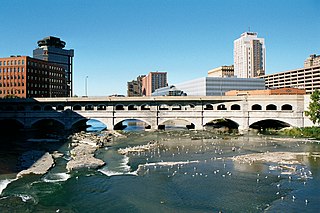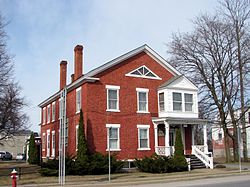
This is a list of the properties and districts listed on the National Register of Historic Places listings in Onondaga County, New York. The locations of National Register properties and districts may be seen in a map by clicking on "Map of all coordinates". There are 170 properties and districts listed on the National Register in the county. Of those, 55 are outside Syracuse, and are listed here, while the rest are covered in National Register of Historic Places listings in Syracuse, New York. One property, the New York State Barge Canal, spans the city and the remainder of the county.

This list is intended to be a complete compilation of properties and districts listed on the National Register of Historic Places in Rensselaer County, New York, United States. Seven of the properties are further designated National Historic Landmarks.

King Manor, also known as the Rufus King House, is a historic house at 150th Street and Jamaica Avenue in Jamaica, Queens, New York City. It was the home of Founding Father Rufus King, a signatory of the United States Constitution, New York state senator, and ambassador to Great Britain immediately after the American Revolution. Descendants of King's family lived in the house until 1896 when Rufus' granddaughter Cornelia King died and the house was sold to the Village of Jamaica. When the western half of Queens, including Jamaica, became part of the City of Greater New York, the house and the property were turned over to the New York City Parks Department which redesignated the land as Rufus King Park.

The Campbell–Whittlesey House, also known as the Benjamin Campbell House, in Rochester, New York is an historic Greek Revival home, designed by architect Minard Lafever. It was built in 1836, and added to the National Register of Historic Places on February 18, 1971.
The National Register of Historic Places listings in Syracuse, New York are described below. There are 116 listed properties and districts in the city of Syracuse, including 19 business or public buildings, 13 historic districts, 6 churches, four school or university buildings, three parks, six apartment buildings, and 43 houses. Twenty-nine of the listed houses were designed by architect Ward Wellington Ward; 25 of these were listed as a group in 1996.

Quackenbush House is a historic building in Albany, New York. It is a house with a double-pitched gable roof that was built in about 1736. It was listed on the National Register of Historic Places in 1972.

North Main Street Historic District in Canandaigua, New York is a historic district that was listed on the NRHP in 1973.

Lowertown Historic District is a national historic district located at Lockport in Niagara County, New York. The district is predominantly residential in nature, with some commercial structures and warehouses. The mose elegant homes are along Market Street, east of Chapel Street, facing the Erie Canal. Notable structures in this district include the Western Block Company Warehouse, a 2+1⁄2-story stone structure built before 1855; Lockport Bank Building built in 1829, and located at 315-319 Market Street; Washington Hunt House, built in 1831 and home to New York Governor Washington Hunt, and located at 363 Market Street; the former Christ Episcopal Church at 425 Market Street; and the Vine Street School, an Italianate style one-room school built in 1864.

Whig Hill is a historic home located near Plainville, Onondaga County, New York. The main house was built in 1833, and is a 2+1⁄2-story, five-bay, Greek Revival-style brick dwelling with a nearly flat roof. Whig Hill was the principal element within a listing Whig Hill and Dependencies, which included two barn clusters, a tenant house, and other outbuildings. The barn cluster north of Genesee Street, described in 1975, is no longer present, in 2009. The south barn remains.

Macedonia Baptist Church, more commonly known as Michigan Street Baptist Church, is a historic African American Baptist church located at Buffalo in Erie County, New York. It is a brick church constructed in 1845. Samuel H. Davis was the congregation's fifth pastor, helped raise money for a church building, and as a mason did much of the construction himself. He gave the welcoming address at the 1843 National Convention of Colored Citizens of America.

There are 75 properties listed on the National Register of Historic Places in Albany, New York, United States. Six are additionally designated as National Historic Landmarks (NHLs), the most of any city in the state after New York City. Another 14 are historic districts, for which 20 of the listings are also contributing properties. Two properties, both buildings, that had been listed in the past but have since been demolished have been delisted; one building that is also no longer extant remains listed.

Erie Canal: Second Genesee Aqueduct, also known as the Broad Street Aqueduct or Broad Street Bridge, is a historic stone aqueduct located at Rochester in Monroe County, New York. It was constructed in 1836–1842 and originally carried the Erie Canal over the Genesee River. The overall length of the aqueduct including the wings and abutments is 800 feet (240 m). The aqueduct is 70 feet (21 m) wide and has large parapets on either side. It is one of four major aqueducts in the mid-19th century Erie Canal system. In 1927, a roadbed was added to carry automobile traffic and named Broad Street. It also carried a part of the Rochester Subway.

Powers Building is a historic office building located in Rochester in Monroe County, New York. It was built in 1869 and is a nine-story, 165-by-171-foot building, laid out around a large open stairwell in the center. It features a triple mansard roof and observation tower which were added after initial construction, between 1873 and 1888, by Daniel Powers to maintain its standing as the tallest building in Rochester. It was designed by noted Rochester architect Andrew Jackson Warner.

Fall Street–Trinity Lane Historic District is a national historic district located at Seneca Falls in Seneca County, New York. The district includes the archaeological remains of 19th century industrial structures located on three islands in the Seneca River. Also included are the limestone Trinity Church (1886) and its associated parish house (1916) and the red brick "The Armitage" historic home built about 1850. Other structures include the board and batten "Cline's Barn" and a rectangular 1920s bandstand.

Market House, also known as The Market Hall and The D.L.& W. Hall, is a historic market building located at Oswego in Oswego County, New York. It was built in 1835 and is a massive brick and stone structure overlooking the Oswego River. The structure originally housed several government entities including city hall. A new city hall was constructed in 1870 and completed in 1872. A section of the basement is believed to have been used as a jail. In 1864 the city sold it to the Oswego and Syracuse Railroad, that used it for the next 80 years as office and storage space. The railroad upgraded the building with a bracketed cornice and elaborate cupola.

This is intended to be a complete list of properties and districts listed on the National Register of Historic Places in Rochester, New York, United States. The locations of National Register properties and districts may be seen in an online map by clicking on "Map of all coordinates".

The William Bailey House is a historic house located at 176 Cornelia Street in Plattsburgh, Clinton County, New York.

Cornelia–Putnam Historic District is a national historic district in Ridgewood, Queens, New York. It includes 87 contributing buildings built between 1907 and 1922. They consist of two story, flat front brick rowhouse dwellings with one apartment per floor and three story tenements with two apartments per floor. They are constructed of yellow and amber brick with brownstone trim.

The Amaziah and Cornelia (Wait) Cannon House, also known as Crab Apple Grove, is a historic building located in Mason City, Iowa, United States. New York natives Amaziah and Cornelia Cannon settled here from Wisconsin in 1866 with their three children. They built this 1½-story stone house the same year in a grove of crab apple trees. It is one of three stone houses built during the settlement era remaining in Mason City. It was occupied by the Cannons and their descendants until 1963, when the present house on the farmstead was built immediately to the east. This house is currently unoccupied and in a deteriorating condition. It has been used as a workshop intermittently. At the time of its construction it was 3 miles (4.8 km) northwest of town, but the farmstead was incorporated into the city limits in the 1970s. The immediate area has remained rural, however. The house was listed on the National Register of Historic Places in 2004.

The Boonton Historic District is a 9-acre (3.6 ha) historic district along Main, Church, Birch, Cornelia, and Cedar Streets in the town of Boonton in Morris County, New Jersey. It was added to the National Register of Historic Places on September 29, 1980, for its significance in architecture. The district has 22 contributing buildings, including the Boonton Public Library, which was previously listed individually on the NRHP.























